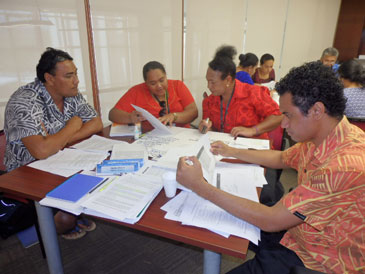
Tuesday 14 October 2014, Secretariat of the Pacific Community (SPC) – Suva, Fiji: sWhat is the true cost of a disaster in human and economic terms and, once we know, what can we do to reduce the burden the next time?
These are the questions that were considered last week by a group of 29 participants as they completed Samoa’s first national training course in “Post Disaster Needs Assessment” (PDNA). The training, supported by the African, Caribbean and Pacific Group of States (ACP) – European Union (ACP-EU)-funded “Building Safety and Resilience in the Pacific Project” (BSRP) is implemented by the Secretariat of the Pacific Community (SPC) and forms part of Samoa’s preparations for the forthcoming Tropical Cyclone season.
Samoa presently leads the way in conducting PDNAs in the region, having already conducted two assessments: the first in 2009, following the earthquake and tsunami and, the second in 2012, following Tropical Cyclone Evan. Both Assessments revealed the true economic cost of the disasters, far exceeding original estimates. The level of detail and accuracy contained within the assessments provided a strong foundation for the identification and prioritisation of appropriate measures to effect timely recovery and reconstruction.
The assessments that Samoa conducted in 2009 and 2012 were delivered with support from regional and international partners, such as the World Bank. This training then aims to establish a national pool of experts in PDNA so that, as observed by Assistant CEO of the Ministry of Natural Resources and Environment, Mr Malaki Jakopo, ‘Samoa can strengthen the capacity in national and civil agencies to conduct PDNAs, reducing our reliance on assistance from outside experts and speed up the formation of plans to recover and reconstruct’. The training activity will increase Samoa’s ability to both calculate the cost of damage and loss from future disaster events and to use this data to inform the identification of long-term recovery and reconstruction needs and solutions.
The training was facilitated by Dr Asha Kambon, a specialist in the Post Disaster Needs Assessment methodology, with over 20 years of experience in conducting PDNAs and contributing to the development and refinement of the methodology, with support from Ms Paula Holland and Dr Kirstie Méheux of the Secretariat of the Pacific Community.
About the ACP-EU SPC BSRP Project
The objective of the project is to reduce the vulnerability, as well as the social, economic and environmental costs of disasters caused by natural hazards, thereby achieving regional and national sustainable development and poverty reduction goals in ACP Pacific Island States (PICs). It is also to strengthen the capacity of PICs to address existing and emerging challenges with regards to the risks posed by natural hazards and related disasters, while maximising synergies between Disaster Risk Reduction (DRR) strategies and Climate Change Adaptation (CCA). The project is implemented in the 15 Pacific ACP States: Cook Islands, Federated States of Micronesia, Fiji, Kiribati, Marshall Islands, Nauru, Niue, Palau, Papua New Guinea, Samoa, Solomon Islands, Timor Leste, Tonga, Tuvalu and Vanuatu, with target groups being national governments, communities, civil society, utilities and the private sector.
For more information: contact Ms Paula Holland,
This e-mail address is being protected from spambots. You need JavaScript enabled to view it
or Ms Suzanne Paisley,
This e-mail address is being protected from spambots. You need JavaScript enabled to view it
(+679 338 1377)
Photo caption: Participants from Ministry of Agriculture, Ministry of Women, Community and Social Development, Ministry of Commerce and Labour and Ministry of Finance work through group exercises to identify the damage and loss experienced in the Agriculture sector from a fictional case study.





